"To disagree leads to study, to study leads to understanding, to understand is to appreciate, to appreciate is to love. So maybe I'll end up loving your theory." -John Wheeler
Out there in the Universe, there's a lot to marvel at. Over billions of years, gravity has attracted different portions of the expanding Universe together into large superclusters and filaments, each made up of clusters, groups, and individual galaxies separated by great cosmic voids.
From the observations of this structure on both large-and-small scales and comparison with simulations, we know that in addition to the normal matter in the Universe -- protons, neutrons, and electrons -- there needs to be some type of dark matter, or massive matter that's affected by gravitation, but not by electromagnetic forces or photons.
An entire suite of observations, including the motions of individual galaxies within clusters,
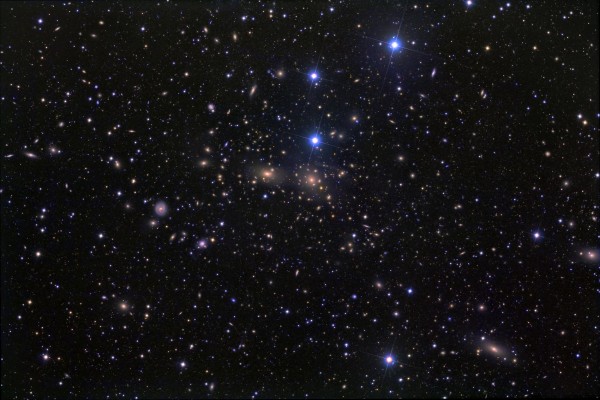 Image credit: Dean Rowe of http://deanrowe.net/astro/.
Image credit: Dean Rowe of http://deanrowe.net/astro/.
the rotation speeds of individual galaxies at various distances from their galactic center,
using the gravitational lensing effect of different galaxy clusters,
and the spectrum of fluctuations in the cosmic microwave background, among others,
all show the same thing: that in addition to protons, neutrons, and electrons, there's about five times as much mass in this new form of matter -- dark matter -- that exerts a well-understood gravitational force but neither absorbs nor emits light, and doesn't collide (as far as we can tell) with protons, neutrons or electrons. So while normal matter (in pink, below) slows down and can even stick together when it runs into other normal matter, dark matter (in blue, below) just passes right through both itself and all other forms of matter.
Whereas a spiral galaxy like our Milky Way may be a few thousand light years thick and maybe 100,000 light years in diameter, the dark matter halo superimposed on our galaxy (and, as far as we can tell, all comparable galaxies) extends for maybe a million light-years in all directions. It's more massive than the normal matter in our galaxy, but it's far more spread out, and it also doesn't clump together into the clumps that are so important to us, like stars, planets, and human beings.
When I first heard about dark matter, I was a prospective graduate student, teaching full-time in California, and while I was visiting the University of Florida, one of the professors was telling me about his experiment searching for one particular theoretical variant of dark matter.
"Hold on," I said to him, "if this dark matter is spread out throughout the entire galaxy, then there should be some of it in our Solar System, too, right? So shouldn't we be able to detect its gravitational effects on the outer planets as compared to the inner ones?"
He brushed my question off, dismissively, and continued on talking about his research. Needless to say, I was unimpressed.
The next day, I told this story to another professor there, and he immediately understood what I was asking, and why it was important. You see, the Sun is by far the dominant mass in the Solar System; to an outstanding approximation, it determines the orbits of the planets. But for Venus, the planet Mercury is interior to it; to a first approximation, Venus' orbit is determined by the combined masses of the Sun plus Mercury. For Jupiter, its orbit is determined by the Sun plus the inner, rocky planets and the asteroid belt. And for any orbiting object in general, its orbit is determined by the total mass enclosed by an imaginary sphere centered on the Sun, with that object at the edge of the sphere.
So if there's a sea of dark matter that permeates space where we are -- all through the Solar System -- the outer planets should see a slightly different (greater) mass than the inner planets. And if there's enough dark matter, it should be detectable.
"Let's calculate it," the professor said to me, and so we spent the next half-hour doing just that. When we finished, we'd found that about 1013 kg of dark matter ought to be felt by Earth's orbit, while around 1017 kg would be felt by a planet like Neptune. These values are tiny; the Sun has a mass of 2 ✕ 1030 kg, while values in the 1013 - 1017 kg range are the mass of a single modest asteroid. Someday, we may understand the Solar System well enough that such tiny differences will be detectable, but we're a good factor of 100,000+ away from that right now.
And that number is only down to around 100,000 now thanks to some new observations, which were egregiously misrepresented by MIT Technology Review. Dark matter is negligible when it comes to Solar System orbits, and it isn't even close to being detectable. In fact, one of the last scientific papers I wrote looked at what happens if all the dark matter that's gravitationally captured by the Solar System over its 4.5 billion year history is (somehow) never re-ejected by the same process that allowed its capture. That's a safe upper limit on the amount of dark matter that the Solar System could conceivably have.
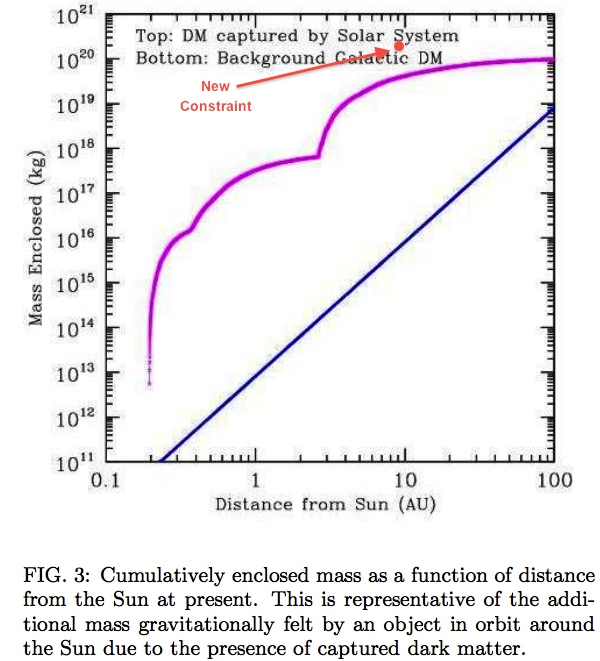 Image credit: X. Xu and E. R. Siegel, via http://arxiv.org/pdf/0806.3767v1.pdf, new "constraint" added in red.
Image credit: X. Xu and E. R. Siegel, via http://arxiv.org/pdf/0806.3767v1.pdf, new "constraint" added in red.
And even in that (admittedly overly) optimistic scenario, at all distances from the Sun, there's still not enough dark matter to even approach the observational limits.
It's a calculation that's accessible to any beginning graduate student, and it's also my own story of how I met the professor who'd wind up becoming my Ph.D. advisor, and the one person who I probably had the best working relationship with in my entire life. But don't be fooled by claims that we haven't detected dark matter in our Solar System gravitationally; we shouldn't at the level of sensitivity we're currently capable of.
But if we put an object whose mass was definitively known into orbit around the Sun a light-year away, and we mapped out all the mass that existed out to that distance around the Sun, that'd be a different story. Hopefully, that's a test we'll someday be able to perform!


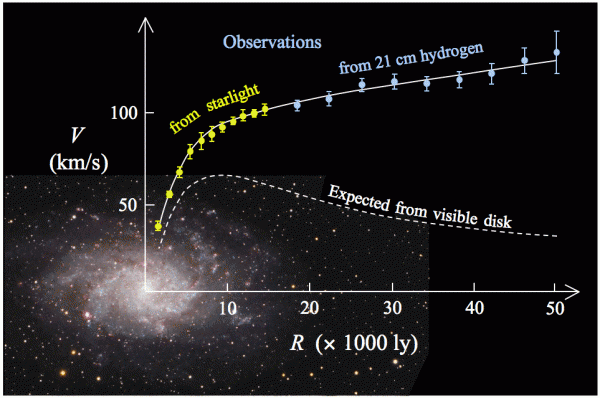
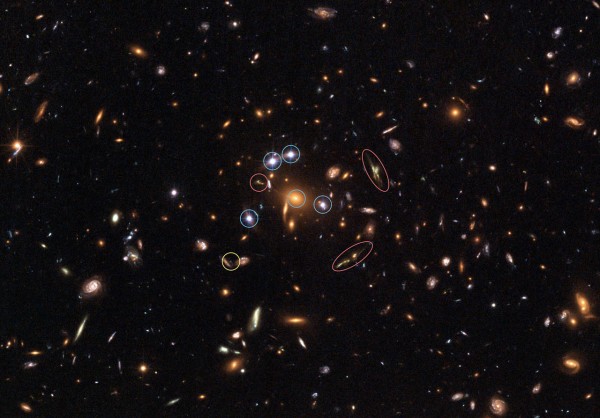
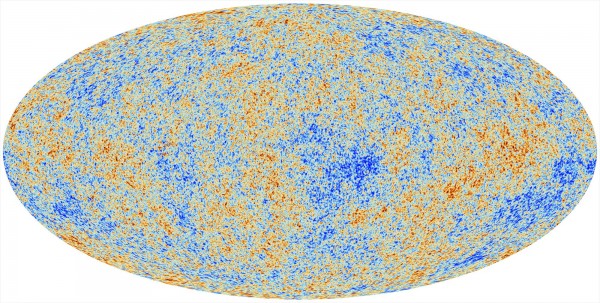
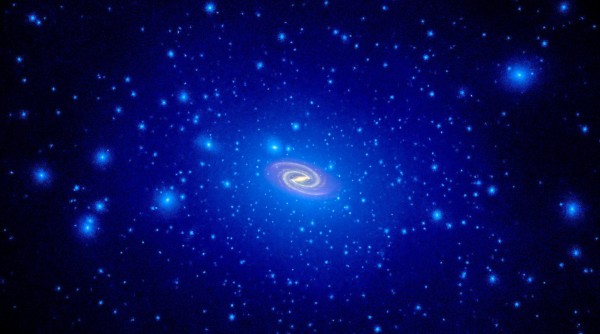


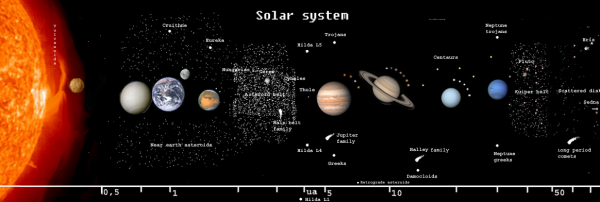
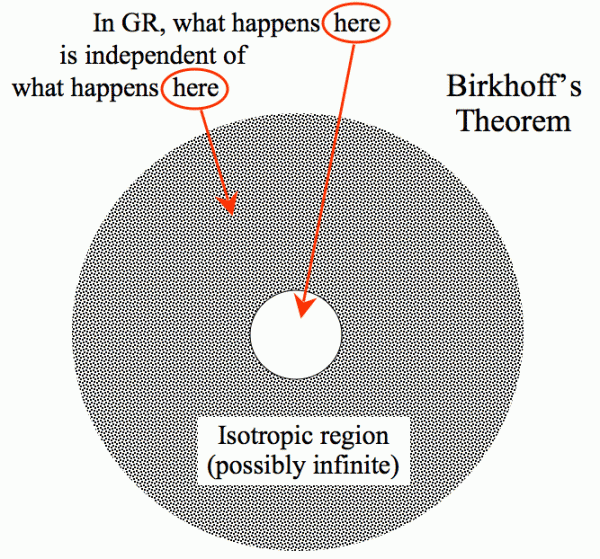
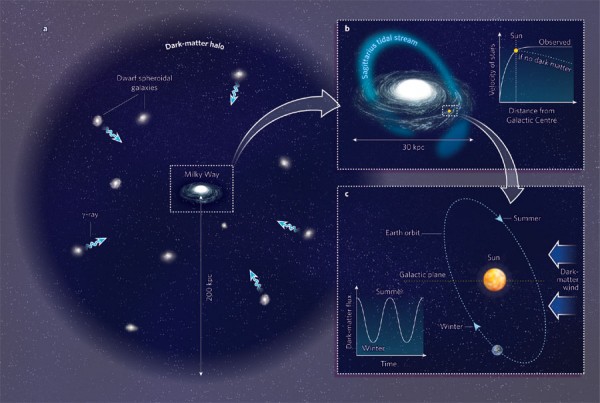
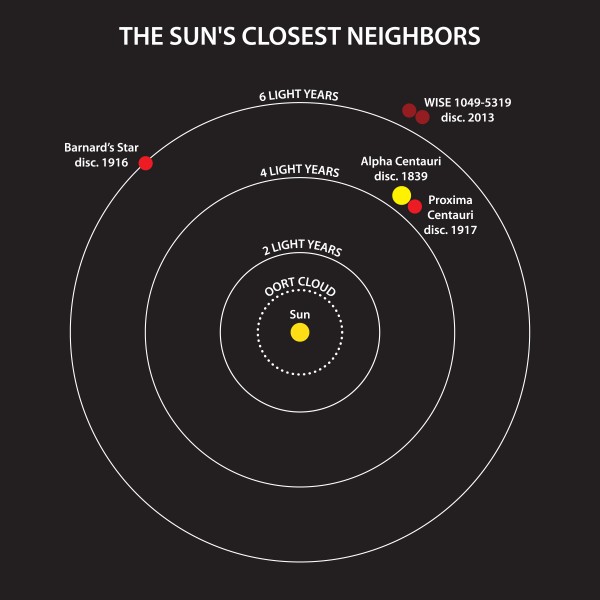
Thanks for the post, very interesting. I'm unclear on one thing though. If dark matter is only affected by gravity, how come it doesn't clump, and how can in that animation remain practically intact?
Clumping depends on the DMs interacting with each other, exchanging energy, and matching velocity.
It's hard enough for a cloud of hydrogen to compress - takes thousands of years! Less interaction, longer time to clump.
Space is space it is a nothing it's got no mass no gravity if there is some thing in space it's got mass and mass got gravity.If you talk about Dark Matter then it must have mass.Therefore if space got neither of the two it can not be mowed or weighed .
The thing that puzzles me about dark matter is why it's usually assumed to be made up of particles*. In his GR foundation paper Einstein said "the energy of a gravitational field shall act gravitatively in the same way as any other kind of energy". And in his Leyden Address he described a gravitational field as inhomogeneous space. There's no WIMPs in there, it's just space, with its non-linear vacuum energy which has a mass equivalence. In an expanding universe where some regions are gravitationally bound, those regions will surely end up with an energy density greater than the surrounding space. So there will be a gravitational effect above and beyond that caused by the matter. Kind of like a galaxy is a bowling ball on a rubber sheet that gets thinner but not under the bowling ball. So it ends up sitting on what is effectively a thick heavy rubber pad. Moreover the place where the thickness of the rubber changes equates to inhomogeneous space. That's what a gravitational field is!
If you google on "inhomogeneous vacuum" you can see various papers, but these never seem to get any media airtime. Space is dark, and there's a lot of it about. But as ever relativity plays Cinderella to particle physics.
* Ethan avoided this, good man,
Because we call matter "particles" and non-matter "energy", John.
P.S.If space is a nothing it can not bend it is the objects in space reacting to one another that's creating the illusion that it is bending space and time or time space does not exist how can it it,s a nothing.
couldn't something be done with the data returning from the voyagers and the pioneers? They are quite a few miles away and presumably we know their exact mass...
John Duffield @4,
The biggest difference between dark matter and other forms of energy (like vacuum energy, homogeneous or inhomogeneous) is their intrinsic pressure. While it's true that vacuum energy and particle energy (energy with non-zero rest mass) do have the same energy densities (the 00 component of the metric tensor), they will have significantly different pressure components (the 11, 22, and 33 components of the tensor), and thus will evolve in radically different ways in the expanding Universe.
These are easy to distinguish, and the lack of pressure at all times is how we can not only rule out inhomogeneous vacuum energy as a candidate for dark matter, but also domain walls, cosmic strings, photons, and even the light neutrinos, as they would behave too much like radiation early on. So this is how we not only know that dark matter is some sort of particle with rest mass, but that rest mass is large compared to the kinetic energy those particles had at even early times in the Universe.
In other words, this dark matter is also cold (or possibly warm), but certainly not hot.
@Ethan #8: All points noted, I'm no fan of domain walls or cosmic strings or similar exotica, and if you can point me at a reference I'd be grateful. But meanwhile see the shear stress components (12 13 23) of the stress-energy-momentum tensor. Shear stress!? Space is kind of "elastic", it has a tension to it that tends to confine its own pressure, just as pressure is confined when energy is tied up in the guise of a particle. You know how the bag model features a strong-force tension? In low energy proton-antiproton annihilation to gamma photons, it appears to disappear. I don't think it does. Instead I think the photon propagates because of a combination of tension and pressure, like a ripple in a rubber mat. Related to this, cosmologists tend to say dark energy is responsible for the increasing expansion of space and Λ stays constant, but IMHO that breaches conservation of energy and in terms of fundamental physics, just can't be right. An alternative is that the increasing expansion is down to a reducing "tensile strength of space" instead. Shades of Einstein-Cartan and f(r) gravity I know, but play around with a stress-ball for an analogy of the expanding universe, and with drooping strands of silly putty to get a gut feel for it. Anyway, sorry to drag you off topic, but this is interesting stuff.
a long winded answer for: No
%google: (0.3 GeV/c^2/cm^3)*(1 AU)^3/(Mass of Sun) = 10^-18
How does the dark matter upper limits as determined by Pitjev compare to the expected dark matter density based on the galaxy's rotation ? You seem to imply that it would not be measurable, yet the Pitjev paper implies that there is less in the Solar System than expected.
have you compared the spiral galaxy rotation curve...same as above...
to the graph of binding energy to nuclide mass... often presented upside down...
the similarity is just too much ...
go check it out
whatever it is... out of all the radiation and particles we know of... and the ones we don.t yet know of...Gravity may vary across. massive bodies of matter.
because of absorption of the energy into that matter.On the Lesage principle... what goes through is less than what arrives at the edge...from All directions.
this makes big G understandable...geometrically .. and explains the variation in the force at great distance.
The pionee efect
The pioneer effect took 20years to solve and has been put down to heat radiation ...40Watts only.
also solar sails effect ...pushing craft outwards...points to the power of photons .
if Gravity and radiation obey the inverse square law ...why not assume ALL RADiATIONS cause Gravity.
in Newtons equarion
All radiation is energy and therefore does act as a source of gravity, according to Einstein.
However the amount of photon energy in the modern universe is far, far, too low to explain anything via its gravitational effects.
The problem with figuring out the Pioneer anomaly was that the effect was so small it took very precise finite-element analysis of how radiation was emitted and reflected off the structure to solve. Similarly, solar sails aren't chosen for their high thrust. Also, this has nothing to do with their relationship with gravity.
Hypothetically, if there was no dark matter in our galaxy, how would it look and act? Does dark matter affect the shape and/or motion of our galaxy? Did it affect the formation of our galaxy? Would it be different if dark matter didn’t exist?
@16
I tried to find some reference in google of full run simulations without DM component, but couldn't find anything.
To my mind, things would fly off more. As far as I know, interactions between DM and matter in galaxy formation is complex. Certainly without DM component, the rotational speed of galaxy wouldn't be the same. At current speed without DM, stars would be ejected from the disk.
Maybe without DM some forms of galaxies would form here and there, then again maybe not. If someone has links to simulations without DM, please share.
Our galaxy would likely have been smaller, as would just about every galaxy.
There would have been more galaxies, however.
#17 - Stephen Adler at IAS calculated the earth/moon DM volume as 24 trillion mt (Journal of Physics A, 10/17/09). #8 - Hold on, Ethan, with this inhomogeneous, anticlumping, vacuum energy (VC), intrinsic pressure thing. Let us consider this Archimedes variation: "A massive body, immersed in space, displaces a volume of that space, centered on such body, that contains an amount of VC that equals the mass of such body, and varies as a function of the distance from such body." The displacement, induced by such body (IB), would be equal and opposite to the attraction of gravity, and would constitute a repellent force of nature. It follows that very little VC would locate at the surface of the IB (Casimir experiment), and most VC would be displaced, in a concentrated halo, at a great distance from the IB (galactic observations). Since the mass of the IB is a constant, that distance is finite, as is the volume, so that intrinsic pressure is not a requirement of clumping (halo formation).
The proposition that 'dark matter' NEVER interacts with normal matter is not logical. The smallest particles we know of, neutrinos, occasionally interact with atoms. Given the likely number of these particles, I would expect; 1)some interaction with normal matter, and, 2) some interaction with other dark matter. There should be some kind of track or radiation from each of these interactions
@William McDill #21: You're exactly right. And there are a dozen-ish experiments active today (including CDMS, to which I belong) which are looking for just those occasional interactions.
Specifically, we (CDMS) look for a dark matter particle striking a nucleus of germanium in a cryogenically cooled crystal. The recoil of that nucleus will produce phonons (vibrations of the crystal lattice) and electron-hole pairs, which can be picked up with suitable sensors attached to the crystal.
So far, none of these experiments have unambiguously detected a signal (look up "DAMA" and "CoGENT" for unconfirmed, but intriguing, exceptions). The current limit on the cross-section (our physicists' way of labelling "probability of interaction) is around 10^-42 cm^2. For comparison, the cross-section for a neutron to hit a uranium nucleus and cause fission is around 10^-24 cm^2 (one barn).
So it isn't really that dark matter "never" interacts, is that it interacts so infernally rarely that not only do we not get to see it in the lab, but the interactions are insufficient to affect cosmological structures.
andyo (#1) consider a spacecraft being 'inserted' into orbit around a planet: The momentum that it had that brought it into the planet's orbit plus the potential energy that it gains falling into the planet's gravitational well is going to be enough to carry it back out again, unless you slow it down somehow... retrorockets or aero-braking.
Regular matter can do this sort of 'breaking' when it enters the solar system... A particle just needs to bump into a slower particle, or one going in the opposite direction -- or even photon pressure from the sun.... A photon gets thrown off in the 'wrong' direction, and the next thing you know, you've been captured by the solar system.
If dark matter interacts very weakly as it enters the solar system's gravity well, then it has (almost) nothing to slow it down as it enters the system,, so it enters, gains speed, and then just leaves .. ultimately travelling roughly the same speed as it did before it entered the solar system's gravity well.
("Nothing interesting here, just a couple of planets and a star ... move along.)
from Kelsey's comments, i'm guessing that dark matter is 10^18 less likely to interact with real matter than a neutron... so going right through the center of the earth would be like a neutron going though a gauze about .01nanometres thick. (i.e. less than an atom's average thickness)
I think your use of the Birkhoff's theorem is incorrect for calculating the effect of galactic dark matter on the planets of the sun.
This theorem states that for any spherically symmetric distribution of mass, the effect of the spherical shells further than you from the center is null (on you and on all other points inside theses shells).
Using this theorem for a ball of galactic dark matter centered on the sun is incorrect. Only the effect of the dark matter _captured_ by the sun can be computed this way. (And then only if it’s been captured in a spherically symmetric way, and not in a flattened disk as I suspect.)
If the galactic dark matter repartition is spherically distributed around the galactic center, then the only valid application of the theorem would be by considering the ball of dark matter centered on the galactic center, and going all the way to the earth.
If it has an even wider distribution, spreading across the whole local group of galaxies, or further, the center would have to be moved even further.
About dark matter itself.
We know it’s there. We know nothing about it.
Any discussion about it properties is conjecture, not fact.
All particle theorists love it because they’re convinced dark matter will eventually end up being made of the last particle/field they invented. (And prove they’re geniuses.)
Let me make a few conjectures myself:
- Dark matter is not just one kind of particles, but the sum of many distinct things we’ve not discovered yet. As time advances, we’ll find one, then a second, etc. But there will always be some mass unaccounted for.
- Most of dark matter will just be plain old matter we’ve not been able to observe yet.
Maybe because it’s gas in a temperature range we’re not observing efficiently now.
Maybe because it’s solid in the form of stones, or larger hard object (Free asteroids, small planets), with a negligible surface-to-mass ratios.
There are surely many other possible alternatives that nobody has yet thought about.
- Maybe it’ll end up to be made of just a few thousand isolated mid-sized black holes, invisible now, but with a huge combined mass.
(From the core of the small galaxies the Milky way swallowed in its youth?)
- Neutrinos have mass, and contribute to a small part of dark matter. (But nobody knows precisely how much.)
- Photons have no mass, but they do have energy. I’ve never seen them accounted for in this calculation.
- The giant black hole at the center of the galaxy changes the galactic gravitational field law. (It’s not 0 in the center anymore). I’ve never seen a clear discussion of the effect of that.
What else? (And yes, unknown particles _are_ a possibility.)
The creation of a disk structure depends on the viscous losses in the medium. Since dark matter interacts with itself or ordinary matter a hell of a lot less, the disk structure of normal matter would take a similar number of orders of magnitude longer to form.
"All particle theorists love it because they’re convinced dark matter will eventually end up being made of the last particle/field they invented. (And prove they’re geniuses.)"
Although "I is a genius" is obviously one option for why they look, it's not the only one.
Why take up science when taking up sports or business administration gets you noticed much quicker with more power?
Scientists get little approval from most people, so it can't be for the respect alone.
There are various reasons for wanting to do science, and each one has a different reason for wanting to find the answer to the questions left unanswered in their field.
You're able to do it, so you enjoy it for itself.
You're unable to do anything else, so you're looking to excel to prove you're a worthy human being.
You just love finding out things.
Your pride won't let the universe win on this one.
You get noticed and a huge whopping bag of money.
Because you can.
Science is no less a job than working a lathe. Science is no less a career than being an MBA. Science is no less fun than professional sport.
And they all have reasons for why people try to do well at them. All include "I is a genius!", but none of them have it as their sole reason.
"But there will always be some mass unaccounted for."
Are you saying there are an infinite number of stable particle forms in the universe? Because if the number is not, then this statement is wrong.
It's even more wrong than "There will always be some species that have not been found", since new species will form as long as live can mutate and pass on their changed genetic heritage. Elemental particles don't have genetic drift.
Very rich webpage and nice pictures. Provided a link here from a post I made on FQXi blog. I sent you and your co-author my view on dark matter a few years ago but didn't get a response. Nevertheless, earth bound dark matter has become a reasonable speculation in view of dark matter abundance and its gravitationally interacting property. Stephen Adler has considered it and published a paper on this in regard to space fly-by anomalies. However, the statement, "there’s still not enough dark matter to even approach the observational limits" may be so because you are straining your eyes so hard to find dark matter far afield whereas it may be right under your nose. Suppose indeed, there is an earth-bound dark matter halo will this not have obvious effects on light experiments on earth surface? I have indeed speculated that dark matter may have been an unknown participant in the drama of 1887 (Michelson-Morley experiment) leading to Special relativity in 1905 (http://arxiv.org/abs/0902.3790). Michelson, Morley, Einstein and others cannot be blamed. But today, knowing its abundance and presence in the solar system, it will be foolhardy not to consider its presence whenever we perform experiments on light's dynamical behaviour. Until proven otherwise I consider the null Michelson-Morley finding indicating isotropy of light observations on earth surface irrespective of earth motion, existing side-by side with anisotropy of light originating distant to earth surface (e.g. CMBR) as providing a contrary claim to the statement, "there’s still not enough dark matter to even approach the observational limits".
I just thought I'd ask a question of those out there much more informed about this matter than I. I'm not a physicist, but have a fairly good background in at least basic physics, so please forgive my ignorance of the more complex aspects, but does anyone know the actual computational process that goes through calculating the amount of dark matter out there? If so, do you know if they assume that the gravitational constant is 6.67×10−11 N·(m/kg) when being applied to dark matter? Is it possible that the gravitational constant for dark matter may be different than for ordinary matter thus miscalculating the position, mass, or velocity of the dark matter? I am assuming they must use some gravitational constant if gravity is the only force that seems to affect the dark matter.
Just found this article. I got me to thinking ....
If the Voyager I probe continue to function for some time to come, at what point will it's trajectory be influenced in a measurable way by the dark matter in the solar system.
Referring to your diagram of our local neighbourhood, Voyager-1 is creeping toward the Oort cloud and is currently (according to Google) about 0.0015 light years away from the Earth.
AS a poet, I speculate Dark Energy appeared and preceded the Big Bang by an infinite moment, Dark Matter its product shaping and forming the Cosmos, its constituancylike shapeless gravity, itself a by-product of Dark Matter which in tandem with Dark Energy is the glue of the Cosmos.
I know dark matter effects have been seen in structures the size of galaxies and larger...
But what are the *smallest* structures where dark matter effects have been seen? Globular clusters possibly? What scale must be encompassed to start actually observing the effect? I've never seen this question addressed directly... Thanks
We've had galactic lensing from matter that is not otherwise visible, Cal. Such masses must be about that of a globular cluster to manage that.
Because they only manage to interact gravitationally, you need thousands of solar masses to make an observation of its effects with our current abilities.
Genetic damage from dark matter may give another way to spot it on the atomic scale. This blog has a section on that.
You left out primordial capture during the formation of the solar system, which is much more efficient at gravitational capture than the N-body interactions required to capture DM since. Primordial capture would result in something more like 10^-5 to 10^-7 solar masses being captured (and retained - the trouble with the N-body capture is that most of the captured DM is lost the same way). If the DM is WIMPs or Axions then this would remain as a large, more or less spherical ball centered on the Sun. It the DM is macroscopic, then it will now (mostly) reside in the centers of gravitating bodies.
Aye, definitely did not consider that, I only considered what we could detect, not what could be (but broke that "I only" with the idea of DNA damage from DM, so mea culpa).
Dark matter are particles with negative mass. Cheers.
No they aren't!
Isn't it odd that although dark matter accounts for some 70% of the mass of the universe, in our Solar System it is deemed to be "neglible"? Why? Seems an awfully convenient way of maintaining this fable of dark matter or dark energy. Could it be that Einsteinian gravity is simply not complete enough to describe all we're seeing in the universe? It was once hypothesized that a planet Vulcan must exist to explain the eccentricities in the orbit of Mercury until it was discovered that Newtonian Gravity was not a complete picture. Couldn't it be that gravitational lensing is awaiting a new theory of physics rather than trying to form fit the current theory?
In the 1950s and 60's people did calculations of how long a star like ours might last given the amount of Hydrogen fuel in its core and its mass.
Now that we know there is a significant amount of dark matter in the Cosmos, #1 could slow dark gravitationally bound dark matter contribute to the mass of solar cores? And #2, should the 8 Billion year estimated lifetime of our sin burning hydrogen fuel be significantly affected?
If half the mass of the Sun is dark matter and not hydrogen, it would seem that would be a bummer.....
Aren't black holes capable of containing huge amounts of stuff. Could the dark matter be in black holes?
I know I'm stupid, but how do people measure what is in a black hole, and is it still consider part of our universe?
Could most of the dark matter and energy be hidden in black holes? Do scientists even know how many black holes there are, and could they be carrying their mass in a sub space form, that contains huge amounts of mass in an infinitely small space. Sorry to interject my silly thoughts. I just wanted to be a part of this discussion because my tiny brain loves this stuff for some reason. All you brilliant brains, I treasure you, and your desire to make sense of things. Thanks for being genius' and thanks for reaching out to each other and letting me listen in.
Mike I think your comment about black holes makes a lot of sense!